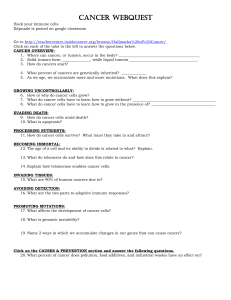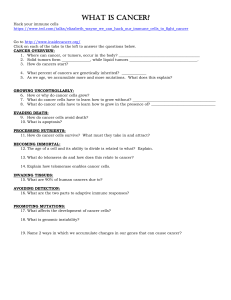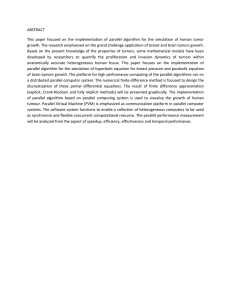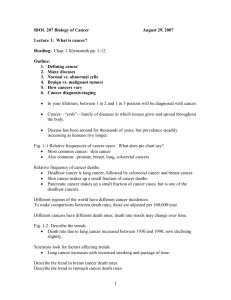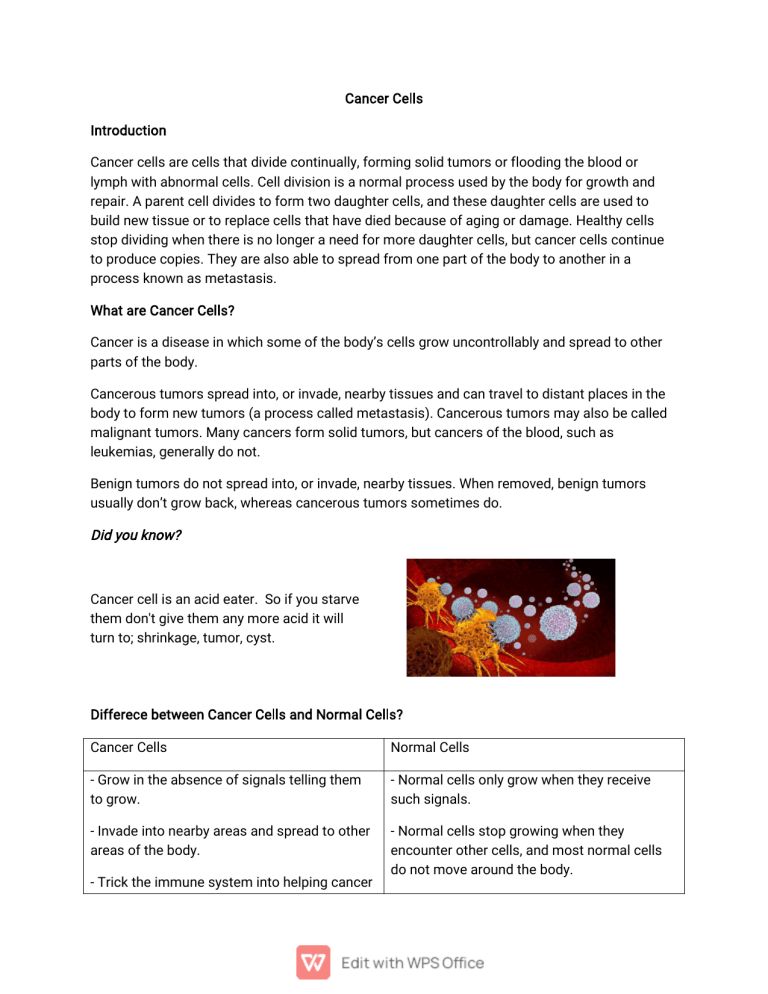
Cancer Cells Introduction Cancer cells are cells that divide continually, forming solid tumors or flooding the blood or lymph with abnormal cells. Cell division is a normal process used by the body for growth and repair. A parent cell divides to form two daughter cells, and these daughter cells are used to build new tissue or to replace cells that have died because of aging or damage. Healthy cells stop dividing when there is no longer a need for more daughter cells, but cancer cells continue to produce copies. They are also able to spread from one part of the body to another in a process known as metastasis. What are Cancer Cells? Cancer is a disease in which some of the body’s cells grow uncontrollably and spread to other parts of the body. Cancerous tumors spread into, or invade, nearby tissues and can travel to distant places in the body to form new tumors (a process called metastasis). Cancerous tumors may also be called malignant tumors. Many cancers form solid tumors, but cancers of the blood, such as leukemias, generally do not. Benign tumors do not spread into, or invade, nearby tissues. When removed, benign tumors usually don’t grow back, whereas cancerous tumors sometimes do. Did you know? Cancer cell is an acid eater. So if you starve them don't give them any more acid it will turn to; shrinkage, tumor, cyst. Differece between Cancer Cells and Normal Cells? Cancer Cells Normal Cells - Grow in the absence of signals telling them to grow. - Normal cells only grow when they receive such signals. - Invade into nearby areas and spread to other areas of the body. - Normal cells stop growing when they encounter other cells, and most normal cells do not move around the body. - Trick the immune system into helping cancer cells stay alive and grow. - Rely on different kinds of nutrients than normal cells. How Does Cancer Develop of errors that occur as cells divide. of damage to DNA caused by harmful substances in the environment, such as the chemicals in tobacco smoke and ultraviolet rays from the sun. they were inherited from our parents. Cancer is a genetic disease—that is, it is caused by changes to genes that control the way our cells function, especially how they grow and divide. Did you Know? Cancer love Sugar. Sugar comes in many different forms, but the simplest form is a single molecule called glucose. All cells, including cancer cells, use glucose as their primary fuel. How does cancer arise and why is it so complex? Since cells grow and replicate faster within tumors, the chance that damaged cells will accumulate more DNA variants increases. This, in-turn, can grow the size and speed of a tumor’s development. Despite these challenges, the research community remains strong, creative, and dedicated to finding treatments, and more people are surviving cancer than ever before. Types of Genes that Cause Cancer The genetic changes that contribute to cancer tend to affect three main types of genes: o Proto-oncogenes are involved in normal cell growth and division. o DNA repair genes are involved in fixing damaged DNA. o Tumor suppressor genes are also involved in controlling cell growth and division. Did you Know? According to Dr. Jed Fahey scientific research, that Broccoli Sprouts have 20 to 100 times more of the Anti-Cancer properties. When Cancer Spread to other tissues? A cancer that has spread from the place where it first formed to another place in the body is called metastatic cancer. The process by which cancer cells spread to other parts of the body is called metastasis. Metastatic cancer has the same name and the same type of cancer cells as the original, or primary, cancer. For example, breast cancer that forms a metastatic tumor in the lung is metastatic breast cancer, not lung cancer. In other cases, the primary goal of treatment for metastatic cancer is to control the growth of the cancer or to relieve symptoms it is causing. Metastatic tumors can cause severe damage to how the body functions, and most people who die of cancer die of metastatic disease. Did you Know? According to Dr. Thomas Siegfried from Boston College, has said in his research that if you complete a seven day water fast once a year you would reduce your risk of any cancer by 95% because of autophagyprocess. Types of Cancer There are more than 100 types of cancer. Types of cancer are usually named for the organs or tissues where the cancers form. For example, lung cancer starts in the lung, and brain cancer starts in the brain. Cancers also may be described by the type of cell that formed them, such as an epithelial cell or a squamous cell. Here are some categories of cancers that begin in specific types of cells: Carcinoma's are cancers or malignancies that begin in the epithelial cells, which are the cells that make up the skin, and the tissues that line various internal organs and structures. Some of the most common carcinomas affect the breast, lung, prostate, and colon. Leukimia is a group of blood cancers that usually begin in the bone marrow and result in high numbers of abnormal blood cells. These blood cells are not fully developed and are called blasts or leukemia cells. Symptoms may include bleeding and bruising, bone pain, fatigue, fever, and an increased risk of infections. Lymphoma is a group of blood and lymph tumors that develop from lymphocytes (a type of white blood cell). The name usually refers to just the cancerous versions rather than all such tumours. Multiple myeloma, also known as myeloma, is a type of bone marrow cancer. Bone marrow is the spongy tissue at the centre of some bones that produces the body's blood cells.It's called multiple myeloma as the cancer often affects several areas of the body, such as the spine, skull, pelvis and ribs. Melanoma, also redundantly known as malignant melanoma, is a type of skin cancer that develops from the pigmentproducing cells known as melanocytes. Melanomas typically occur in the skin, but may rarely occur in the mouth, intestines, or eye. Brain and Spinal Cord Tumors refer to the masses of uncontrolled cell growth within the skull or the bony spinal column. Brain and spinal cord form the central nervous system or CNS. Tumors may develop in these areas when the genes that regulate cell growth and multiplication become mutated or damaged. Did you Know? Most hair loss during cancer treatment is caused by chemotherapy. That's because chemo targets rapidly growing cells, which damages hair follicles and makes the hair fall out. Thank You References: https://www.cancer.gov/about-cancer/understanding/what-is-cancer
